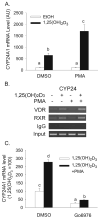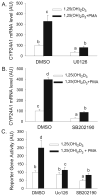Effect of phorbol 12-myristate 13-acetate activated signaling pathways on 1α, 25 dihydroxyvitamin D3 regulated human 25-hydroxyvitamin D3 24-hydroxylase gene expression in differentiated Caco-2 cells
- PMID: 22174178
- PMCID: PMC4536811
- DOI: 10.1002/jcb.24028
Effect of phorbol 12-myristate 13-acetate activated signaling pathways on 1α, 25 dihydroxyvitamin D3 regulated human 25-hydroxyvitamin D3 24-hydroxylase gene expression in differentiated Caco-2 cells
Abstract
Phorbol-12-myristate-13-acetate (PMA), a protein kinase C(PKC) activator, can modulate 1α, 25 dihydroxyvitamin D(3) (1,25(OH)(2)D(3))-induced expression of the 24-hydroxylase (CYP24A1) gene but this has not been studied in differentiated enterocytes, a primary 1,25(OH)(2) D(3) target cell. We found that in differentiated Caco-2 cells, an established model of the mature absorptive epithelial cell, PMA significantly enhanced 1,25(OH)(2)D(3)-induced human CYP24A1 (hCYP24A1) mRNA accumulation and hCYP24A1 promoter-luciferase reporter gene activation by 150%. Reporter gene studies further identified the region between -298 and +74 bp in the hCYP24A1 promoter as critical for the PMA enhancing effect and chromatin immunoprecipitation (ChIP) analysis showed that PMA enhanced 1,25(OH)(2)D(3)-induced binding of vitamin D receptor to this region. PMA can activate PKC, ERK1/2, and p38 MAP kinases and inhibition of these signaling pathways reduced both 1,25(OH)(2)D(3)-induced hCYP24A1 gene transcription and the enhancing effect of PMA. The PMA enhancing effect on 1,25(OH)(2)D(3) action was evident in a minimal promoter with three osteocalcin VDREs and was reduced after mutation of a putative vitamin D stimulatory site in the hCYP24A1 promoter. In contrast, mutation of a Ets binding site (EBS) in the hCYP24A1 promoter had no impact on 1,25(OH)(2)D(3) action or the PMA enhancing effect. These data suggest that in the differentiated enterocyte PMA-induced activation of several signaling pathways contribute to 1,25(OH)(2)D(3)-induced hCYP24A1 gene expression through multiple regulatory motifs within the proximal hCYP24A1 promoter.
Copyright © 2011 Wiley Periodicals, Inc.
Figures






Similar articles
-
Phorbol esters enhance 1α,25-dihydroxyvitamin D3-regulated 25-hydroxyvitamin D-24-hydroxylase (CYP24A1) gene expression through ERK-mediated phosphorylation of specific protein 3 (Sp3) in Caco-2 cells.Mol Cell Endocrinol. 2012 Sep 25;361(1-2):31-9. doi: 10.1016/j.mce.2012.03.008. Epub 2012 Mar 28. Mol Cell Endocrinol. 2012. PMID: 22871965 Free PMC article.
-
Effects of MAPK signaling on 1,25-dihydroxyvitamin D-mediated CYP24 gene expression in the enterocyte-like cell line, Caco-2.J Cell Physiol. 2009 Apr;219(1):132-42. doi: 10.1002/jcp.21657. J Cell Physiol. 2009. PMID: 19097033 Free PMC article.
-
The effect of differentiation on 1,25 dihydroxyvitamin D-mediated gene expression in the enterocyte-like cell line, Caco-2.J Cell Physiol. 2009 Jan;218(1):113-21. doi: 10.1002/jcp.21574. J Cell Physiol. 2009. PMID: 18726998 Free PMC article.
-
The impact of chromatin organization of vitamin D target genes.Anticancer Res. 2006 Jul-Aug;26(4A):2637-45. Anticancer Res. 2006. PMID: 16886674 Review.
-
Vitamin D3-driven signals for myeloid cell differentiation--implications for differentiation therapy.Leuk Res. 2010 May;34(5):553-65. doi: 10.1016/j.leukres.2009.09.010. Epub 2009 Oct 6. Leuk Res. 2010. PMID: 19811822 Free PMC article. Review.
Cited by
-
Potential Therapeutic Implications of Caffeic Acid in Cancer Signaling: Past, Present, and Future.Front Pharmacol. 2022 Mar 9;13:845871. doi: 10.3389/fphar.2022.845871. eCollection 2022. Front Pharmacol. 2022. PMID: 35355732 Free PMC article. Review.
-
Chemical and Pharmacological Aspects of Caffeic Acid and Its Activity in Hepatocarcinoma.Front Oncol. 2019 Jun 21;9:541. doi: 10.3389/fonc.2019.00541. eCollection 2019. Front Oncol. 2019. PMID: 31293975 Free PMC article. Review.
-
Chlorogenic Acid (CGA) Isomers Alleviate Interleukin 8 (IL-8) Production in Caco-2 Cells by Decreasing Phosphorylation of p38 and Increasing Cell Integrity.Int J Mol Sci. 2018 Dec 4;19(12):3873. doi: 10.3390/ijms19123873. Int J Mol Sci. 2018. PMID: 30518116 Free PMC article.
-
Phorbol esters enhance 1α,25-dihydroxyvitamin D3-regulated 25-hydroxyvitamin D-24-hydroxylase (CYP24A1) gene expression through ERK-mediated phosphorylation of specific protein 3 (Sp3) in Caco-2 cells.Mol Cell Endocrinol. 2012 Sep 25;361(1-2):31-9. doi: 10.1016/j.mce.2012.03.008. Epub 2012 Mar 28. Mol Cell Endocrinol. 2012. PMID: 22871965 Free PMC article.
-
Polyunsaturated fatty acids and their endocannabinoid-related metabolites activity at human TRPV1 and TRPA1 ion channels expressed in HEK-293 cells.PeerJ. 2025 Mar 24;13:e19125. doi: 10.7717/peerj.19125. eCollection 2025. PeerJ. 2025. PMID: 40151457 Free PMC article.
References
-
- Almog T, Naor Z. Mitogen activated protein kinases (MAPKs) as regulators of spermatogenesis and spermatozoa functions. Molecular and Cellular Endocrinology. 2008;282:39–44. - PubMed
-
- Armbrecht HJ, Boltz MA, Hodam TL, Kumar VB. Differential responsiveness of intestinal epithelial cells to 1,25- dihydroxyvitamin D3--role of protein kinase C. J Endocrinol. 2001;169:145–151. - PubMed
-
- Armbrecht HJ, Chen ML, Hodam TL, Boltz MA. Induction of 24-hydroxylase cytochrome P450 by 1,25-dihydroxyvitamin D and phorbol exters in normal rat kidney (NRK-52E) cells. J Endocrinol. 1997;153:199–205. - PubMed
-
- Armbrecht HJ, Hodam TL, Boltz MA, Chen ML. Phorbol ester markedly increases the sensitivity of intestinal epithelial cells to 1,25-dihydroxyvitamin D3. FEBS Lett. 1993;327:13–16. - PubMed
-
- Barletta F, Dhawan P, Christakos S. Integration of hormone signaling in the regulation of human 25(OH)D3 24-hydroxylase transcription. Am J Physiol Endocrinol Metab. 2004;286:E598–E608. - PubMed
Publication types
MeSH terms
Substances
Grants and funding
LinkOut - more resources
Full Text Sources
Miscellaneous

